- Hyperspectral study focused on discovery of near-surface
hydrothermal alteration marks a significant achievement;
investigation of further high priority targets has commenced with
surface field investigations.
- U.S. Gold Corp. permitted to drill up to 38,200 feet (11,600
meters) in up to 22 holes, continues to refine priority targets
that have seen little or no historical drilling.
CHEYENNE, Wyo.,
Sept. 12,
2023 /PRNewswire/ -- U.S. Gold Corp. (Nasdaq:
USAU) (the "Company"), a gold exploration and development company,
is pleased to announce the completion of a hyperspectral study of
its 20-square mile Keystone project, located in Nevada's Cortez Trend. This program has
yielded the discovery of multiple high priority targets requiring
further investigation adding to the targets identified from prior
work. A drilling exploration program within the permitted Plan of
Operations is pending and follows
up on encouraging results from the 2019
drilling. Currently the company prioritizes its permitting and
development at the CK Gold Project, remaining committed to
exploration pursuing Carlin-type and gold-silver skarn deposits in
a variety of settings within the broader Keystone land package
enhanced by the hyperspectral data.
In addressing the company's strategy related to exploration,
Kevin Francis, U.S. Gold Corp.'s
Vice President of Exploration and Technical Services said, "While
we've concentrated our focus and resources towards securing permits
and developing our CK Gold Project in Wyoming, we remain mindful of the tremendous
opportunity that we hold in our exploration portfolio. With the CK
Project approaching a permit approval decision early next year, we
have time to turn some of our attention toward exploration,
particularly in Nevada. Conducting
remote hyperspectral studies has not only confirmed our views about
the opportunities at existing target areas but serves to add
targets that would otherwise be difficult to seek out on our
extensive 20-square mile land package. We have a surface
investigation ongoing to follow up on the remote sensing analysis.
Confirmation between the surface investigation and the
hyperspectral study will contribute to further refinement of high
priority drill targets which may advance toward discovery."
For further details on the Keystone Exploration Project, please
visit the company's website.
Hyperspectral Study
To enhance mineral exploration activities, Exploration Mapping
Group, Inc completed a WorldView-3 satellite data remote sensing
project for U.S. Gold Corp. centered over the Keystone project in
Nevada. The component color
alteration images were combined into various groups to facilitate
interpretation of 'hotspots' that represent a zonation of
alteration assemblages. The interpretation process involved
identification of logical color assemblages starting with lower
intensity alteration and moving up progressively to higher
intensity alteration assemblages as shown in the figure below. The
hotspot interpretation was generated to pinpoint areas of spectral
and possible economic significance. The hotspot interpretation is
used to help focus on alteration anomalies for potential field
inspection and also as vector layers for potential combination with
other exploration datasets such as geology, geochemistry and
geophysics. Field investigation and sampling of the highest
priority hot spots is currently underway and expected to be
completed by the end of September
2023.
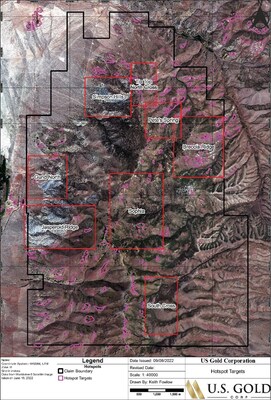
Drilling Program
While currently being refined, up to 22 angled and vertical
drill holes are proposed within five high-potential target areas of
Keystone. Once launched, the drilling program is expected to be
composed of a mix of reverse circulation (RC) and core, especially
within the Sophia target area, where the most encouraging drill
results are associated with extensive void development in Lower
Plate rocks. These areas include Nina Skarn, Sophia, Tip Top,
Greenstone Gulch and Keystone Skarn. Details for each target area
are provided below, in
order of priority. For those targets
with two or more holes
proposed, one hole is expected to be drilled
and then drilling is planned to progress to the next target in
priority allowing time
for results to be returned
and analyzed. Target concept cross sections
are also under development and provided for several
of the targets. See the following property map illustrating
the proposed drill hole locations.
Historical drilling averaged 136 meters targeting shallow
mineralization without investigating potential deeper Carlin-type
mineralization. The 2016-2019 USAU drilling averaged 528 meters and
represents the first effort to explore for deeper Carlin-type
mineralization.
Proposed Drilling Program at the Keystone
Project
The following provides a brief summary description of these
prioritized Keystone drill targets:
Nina Skarn
Up to nine holes are planned in this target area to follow up on
strong gold mineralization encountered in 2019 drilling, within
hole Key19-05rc. Key19-05rc encountered two thick
intervals of oxidized, cyanide
soluble, gold-bearing skarn
mineralization, including 67.06m of
0.194 g/t Au and 76.2m of 0.224 g/t Au, starting from surface. The 76.2m interval
also
contained an interval of 25.91m of 0.408 g/t Au. Lower Valmy and Comus pyroxene
skarn
and hornfels are present at surface, coincident with a +2,000-foot-long gold-in-soil anomaly
with up to 200 ppb samples and associated coincident anomalous
Te-Bi-Zn-Ag. This anomalous skarn zone is parallel to and
appears confined to the east of a major NNW trending structural
zone, which confines strong Carlin-style alteration to the south in
the Sophia Target, and a strong NE trending structural zone at the
north.
The proposed drilling will expand upon Key19-05rc to the north
and southeast, along the Walti Pluton contact and structures
trending southeast toward the Mud Springs intrusion, respectively.
As-Bi-Te-Au in soil anomalies located along the western contact of
the Mud Springs
intrusion are expected to be drill
tested as well. Drilling is expected to test for both oxidized
and reduced skarn style mineralization along and near the contacts
of both intrusions.
A plan map depicting the cross sections in this news release and
cross section of Nina Skarn is illustrated below:
Sophia
Up to four holes
are proposed to be drilled
to follow up on previous
drilling in the target area, especially holes
Key18-09rc and Key18-03rc. Hole Key18-09rc encountered over
350 feet of continuous oxidized breccia at the bottom, where it was
lost at 1600 ft in a 20-foot-wide open void. The oxidized
breccia was located below a thick section of Comus skarn and
hornfels, which yielded a 20-foot intercept of 1g+ gold in
garnet-magnetite skarn. The
breccia at depth displays
strongly anomalous gold, arsenic, thallium,
mercury, antimony and many other elements, including
thallium over 380 ppm. Key18-03rc was lost in collapse breccia
voids in the Wenban Unit 6, with associated silicified,
gold-bearing and quartz-calcite-stibnite veined limestone. Collapse
breccias have been related to ore deposition at Cortez Hills.
Extending from Key18-09rc and south-eastward, a strongly altered
porphyritic dike set is present, along which the strongest Au and
As surface rock and soil anomalies at Sophia are
located. Drilling is expected to be RC pre-collars with core
tails to get through the extensive voids developed at the Horse
Canyon-Wenban contact and down to the targeted Wenban Unit 5 host
rocks, where the altered intermediate dikes are projected to
intersect Unit 5. The Sophia target area represents the largest As-Tl soil anomaly
within the entire Keystone project. A target cross
section for Sophia is given below, refer to plan map above for
section location.
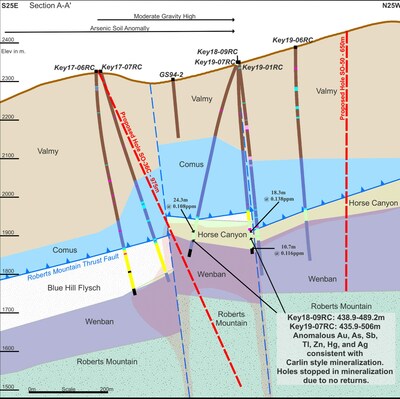
Greenstone Gulch
Two holes are planned in this area, which has seen no previous
drilling. Upper Plate Cambrian-Ordovician Comus
Formation calcareous siltstones, limestones and greenstones
are exposed at surface and are variably altered along NW and NE
trending, partly dacitic dike filled structural zones. Lower
Plate Devonian rocks are expected at shallow depths below
surface. Surface soil and rock geochemistry shows a strong
pathfinder element anomaly coincident with the NW structural
zones. Gold mineralization encountered in the
Nina Skarn target area suggests
the Greenstone Gulch area may be prospective for Carlin-
type gold mineralization, in a similar geologic and structural
setting as the Cove-McCoy mining district in Lander County, Nevada, another
gold-polymetallic mineral rich, Eocene magmatic center. Comus
at Keystone is lithologically similar to the Hales Formation, the
primary host rock of Carlin-type gold mineralization at the Tonkin
Springs mine, five miles east of Keystone. Targeting
collapse breccias and bedding replacements developed in
lower Comus, Devonian Horse Canyon-Wenban contact, and Wenban Unit
5. See the attached figure below for the comparison, and a target
cross section:
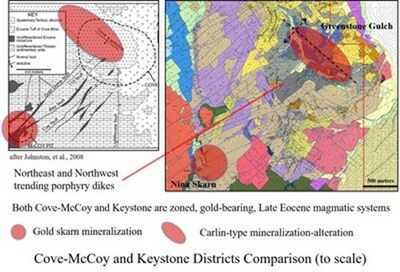
Keystone and Sophia Skarn
Three holes are planned at the Keystone Skarn target area, and
three holes are planned at the Sophia Skarn targets, within the
broader Sophia target area. Holes at Keystone Skarn are
expected be shallow, angled RC holes to test steeply dipping,
high-grade gold bearing (27 g/t+ in rock chips), oxidized skarn
developed along dikes emanating from the Walti
pluton. Previous drilling in the area tested the base metal
rich skarn mineralization of the historic Keystone mine. The
high-grade gold occurrence is located east of the Keystone
mine and has never been drill tested.
Holes at Sophia
Skarn will test several coincident Au-
Bi-Te soil and rock chip anomalies located between the Nina Skarn
and Sophia Carlin-type target areas,
using angled and vertical RC holes. One hole is expected to
follow up on the historic drill hole MP89-2/90-1, which encountered
51.8m of 0.253 g/t Au, including
3m of
2.2 g/t Au. The map below illustrates the various gold-bearing skarn anomalies around the
Mud Springs and Walti intrusions:
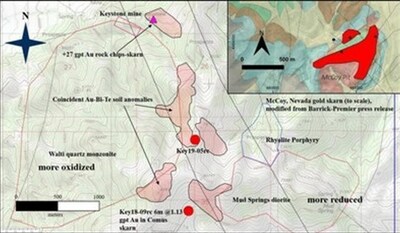
Tip Top
One hole is planned to follow up on previous drilling in the
target area, that encountered encouraging gold and Carlin-style
alteration and pathfinder geochemistry. The target is located
at the intersection of a major NNW trending structural zone with
several NNE and NE trending fault zones that down-drop Upper
Plate rocks against Lower Plate rocks. The
NNW structural zone is identified as a district
scale mineralized conduit at Keystone. Surface
soil and rock geochemistry shows a strong pathfinder and gold
anomaly coincident with a large gravity low and chargeability high
in the immediate target area. Previous drilling has shown
gold, Carlin-style alteration and oxidation are increased along the
NNW structural zone. In addition, a long strike length, NW
striking-shallow dipping structure was identified in
previous drilling, with associated gold and dolomitization. Targeting a Goldrush-style breccia
deposit developed at the intersection of the broad NNW trending
structural zone with the NW striking, shallow
dipping structure, and collapse breccias developed in Wenban Unit 5
in the hanging-wall of the major NNW structural zone. See the
target section below with CSAMT:
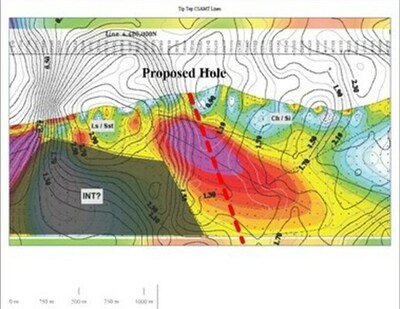
About U.S. Gold Corp.
U.S. Gold Corp. is a publicly traded, U.S.-focused gold
exploration and development company. U.S. Gold Corp. has a
portfolio of exploration properties. The CK Gold Project is located
in Southeast Wyoming and has a
Preliminary Feasibility Study technical report, which was completed
by Gustavson Associates, LLC. The Keystone exploration property is
on the Cortez Trend in Nevada, 11
miles south of Nevada Gold Mines Cortex Complex (Barrick Gold
Corporation - 61.5% and Newmont Corporation – 38.5%) The Challis
Gold Project is located in Idaho,
12 miles south of Revival Gold's Beartrack Project. For more
information about U.S. Gold Corp., please visit
https://www.usgoldcorp.gold/.
Cautionary Note Regarding Forward-Looking Statements
Certain statements in this press release are forward-looking
within the meaning of the Private Securities Litigation Reform Act
of 1995. These statements may be identified by the use of
forward-looking words such as "anticipate," "believe," "forecast,"
"estimated," and "intend," among others. These forward-looking
statements are based on U.S. Gold Corp.'s current expectations, and
actual results could differ materially from such
statements. These forward-looking statements include
statements relating to a pending drill exploration program within
the permitted Plan of Operations; a permit approval decision for
the CK project; the results of confirmation between the surface
investigation and the hyperspectral study, which may contribute to
further refinement of high priority drill targets and advance the
Keystone project toward discovery; expected completion of field
investigation and sampling of high priority hot spots at the
Keystone project; and the launch, scope, locations, timeline and
potential results of the proposed drilling program at the Keystone
project. There are a number of factors that could cause actual
events to differ materially from those indicated by such
forward-looking statements. These factors include, but are not
limited to, risks arising from: market and other conditions, the
prevailing market conditions for metal prices and mining industry
cost inputs, environmental and regulatory risks, COVID-19 risks,
changes in interpretations of geological, geostatistical,
metallurgical, mining or processing information, risks faced by
junior companies generally engaged in exploration activities,
whether U.S. Gold Corp. will be able to raise sufficient capital to
develop the CK Gold Project and implement future drilling programs,
the success or failure of future drilling programs, and other
factors described in the Company's most recent Annual Report on
Form 10-K, Quarterly Reports on Form 10-Q, and Current Reports on
Form 8-K filed with the Securities and Exchange Commission, which
can be reviewed at www.sec.gov. The Company has based these
forward-looking statements on its current expectations and
assumptions about future events. While management considers these
expectations and assumptions to be reasonable, they are inherently
subject to significant business, economic, competitive, regulatory,
and other risks, contingencies, and uncertainties, most of which
are difficult to predict and many of which are beyond the Company's
control. The Company undertakes no duty to correct or update any
information contained herein.
For additional information, please contact:
U.S. Gold Corp. Investor Relations
+1 800 557 4550
ir@usgoldcorp.gold
www.usgoldcorp.gold
 View original content to download
multimedia:https://www.prnewswire.com/news-releases/us-gold-corp-provides-update-on-exploration-potential-at-the-keystone-project-on-nevadas-cortez-trend-301924587.html
View original content to download
multimedia:https://www.prnewswire.com/news-releases/us-gold-corp-provides-update-on-exploration-potential-at-the-keystone-project-on-nevadas-cortez-trend-301924587.html
SOURCE U.S. Gold Corp.